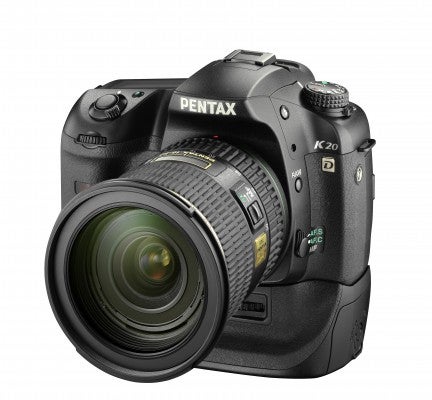An affordable high-resolution camera? Sounds good, but how does the K20D measure up against its rivals?...
Pentax K20D Review
Performance And Image Quality
Performance:
The biggest enhancement over the previous model is the 11-point AF system, which is much faster and more accurate, though at times it does struggle to keep up in continuous shooting mode. The lenses are still the biggest hurdle to this, with Pentax consumer zooms tending to be slower and louder than those from other manufacturers. Unfortunately I didn’t have a chance to test the camera with the new DA* lenses with their faster and quieter SDM AF motor, but hopefully they will provide a better solution. The shutter is responsive and almost on a hair trigger, while the continuous drive of 3fps can hardly be said to be top of the class and it only offers 14 Raw or 38 JPEGs before using up the buffer. During the studio shoot I found it quite frustrating that the camera slowed down so much. This is one area where the camera fails to match the performance of the K10D, which allowed continuous JPEG recording to the card capacity. As the increased resolution results in larger file sizes, it would have been good of Pentax to also include a larger buffer to at least maintain the speed, if not improve upon the performance of the K10D. On the other hand the addition of a PC socket is much more useful, enabling me to use the camera with studio lights without messing around with hotshoe-based PC socket adaptors. I also shot handheld with daylight Kinoflow and HMI lights (daylight-balanced video lights) at relatively slow shutter speeds and, for the most part, achieved some decent and sharp results. However, I contest Pentax’s claims of four stops slower shutter speeds using the built-in sensor-based image-stabilisation system. Two stops would be a safer estimate.
Image Quality:
Best results are obtained from Raw files and it is quite hard to distinguish between the DNG and PEF formats. The advantage of DNG is that the universal format is more likely to be future proof, so is better for archiving. JPEGs are pretty good though, especially if you are correcting the exposure issues in-camera, as the end file will not be as damaged by Photoshop.
Exposure:
I’ve often found Pentax cameras to underexpose slightly and this is certainly true of the K20D. While it could be said to be beneficial to err on this side, in order to prevent the highlights from blowing, the K20D takes matters a little too far. Images are around to 1 stop underexposed, giving them a dull look and either exposure compensation or correction in Photoshop is generally necessary.
Noise:
The lack of noise at higher ISOs is pretty impressive, with better than expected results at ISO 3200, though images get a little too speckled at ISO 6400. They are still usable though, and Raw images should be easily fixed in Adobe Camera Raw or similar processing. At the lower end of the ISO range the results are pretty smooth, with no cause for concern and with noise only starting to make its first appearance at ISO 800.
Tone And Contrast:
The tonality of the images otherwise is pretty good though and final results are pleasing. Other features such as the dynamic range expansion proved useful, but less so than those of the Sony A700.
Colour And White Balance:
White balance is generally consistent and produces pleasing results even under mixed lighting. On occasion I needed to switch to a preset from Auto, but that’s usual. Colour overall is very good, with nice punchy images at the default settings.
Sharpness And Detail:
Image sharpness should be expected at this resolution and the Pentax certainly has plenty of potential. The K20D does produce sharp images, especially when viewed on A4 prints, or on screen. You need to be careful to keep the camera steady, however, as the closely packed pixel population will show up and amplify the effect of any movement. Similarly Pentax’s standard kit zoom lenses are lacking compared to those of some other manufacturers, so it’s worth investing in decent glass for really top-notch results.





